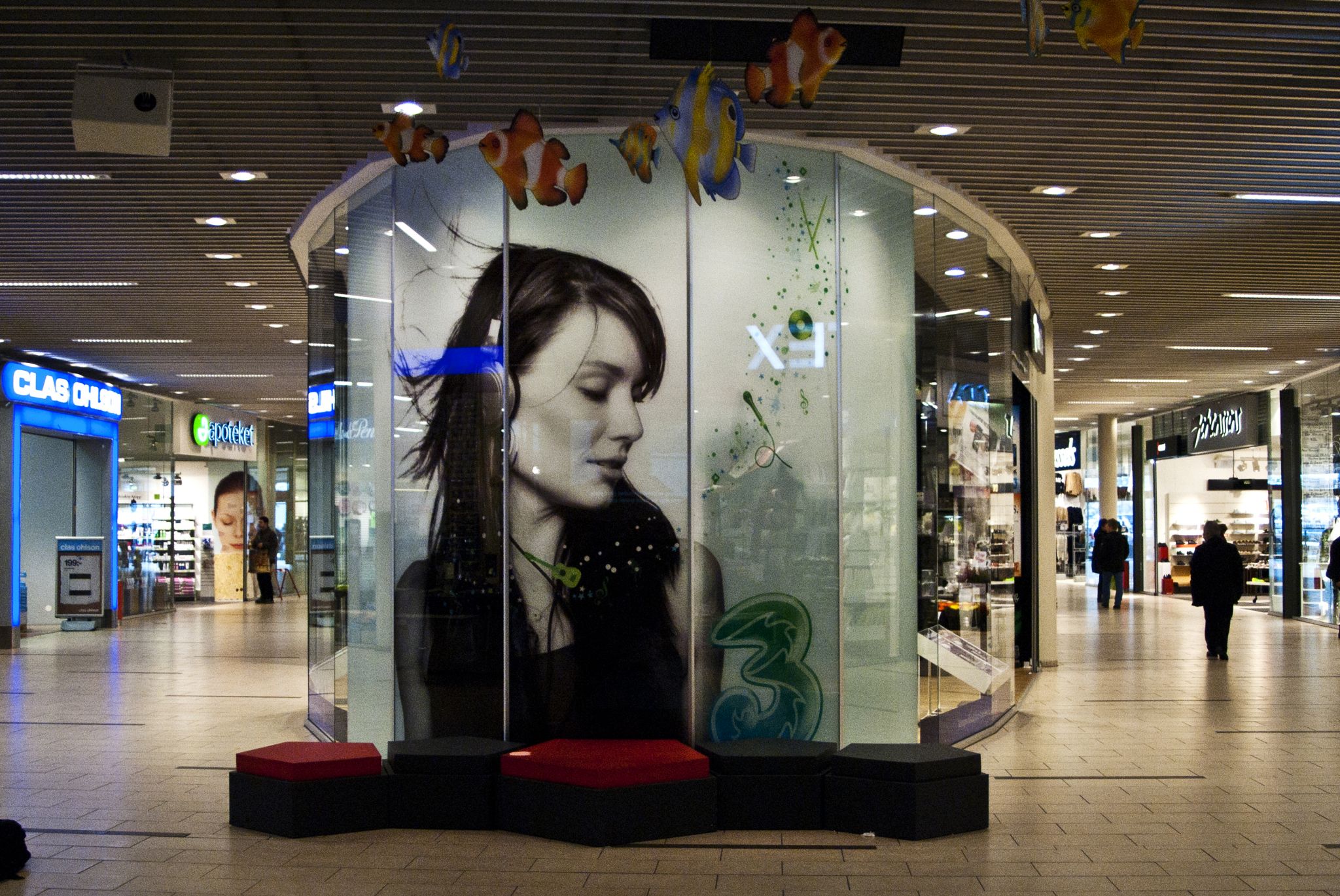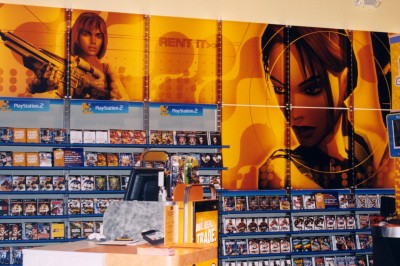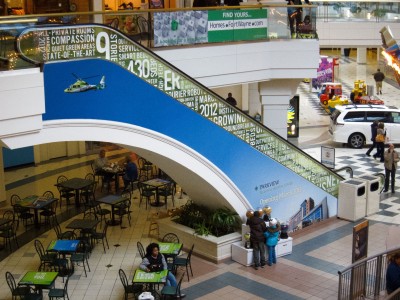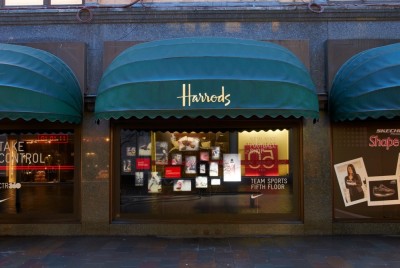Wide-format Printing: A new generation of POP displays
by all | 28 July 2013 8:30 am
 [1]
[1]Photos courtesy MACtac
By Jason Yard
Point-of-purchase (POP) displays have been a staple of advertising in retail environments for many years, ranging from simple merchandising to high-end fixtures and differentiating the many products competing for shoppers’ attention on store shelves. From aisle-end displays to floor decals to window graphics, POP represents many types of media from which retailers may select to convey a promotional message or otherwise communicate with their customers. A multitude of third parties, too, have taken advantage of at-retail advertising opportunities in creative ways.
While they have been established as an important promotional tool, POP displays have also had their shortcomings. Given past limitations in printing technology and material properties, retailers have sometimes found themselves unable to execute fully cohesive campaigns across various media, whether due to a lack of colour consistency, unaffordability or other barriers to achieving their desired effect.
Fortunately, technological developments have addressed many of these shortcomings in recent years. Innovations both in printing and in materials have created new opportunities for POP displays today and tomorrow, with cleaner, higher-end esthetics that were previously impossible.
Printer advancements
Significant progress has especially been seen in printing technology for the sign industry. Indeed, this trend has been one of the most notable developments in terms of changing the POP display market.
Wide- to super-wide-format printers are now compatible with flexible vinyls, rigid boards and even fabrics, offering a consistent appearance for graphics across these media. This is especially important when sign shops are being called upon to print branded pieces that adhere to retailers’ and marketers’ strict colour, logo and image guidelines.
 [2]
[2]Large-format POP graphics have become a staple of retail environments.
Another key to the continued growth of the POP display market has been the capability for many sign shops to produce graphics with a level of quality and special effects that were previously reserved for only the most expensive printing systems.
Even narrow-format printers can now be used for smaller runs of high-quality POP display graphics, supporting more affordable regionalized campaigns. They offer high speeds, colour matching and management capabilities and special effects like raised ink and embossing, all at smaller volumes—and thus lower costs—than were previously available via offset and digital wide-format printing.
Of course, wide-format printers have improved, as well. The introduction of white and metallic inks, for example, has enabled the production of new types of graphics and special-effect finishes for POP displays, particularly window graphics using see-through substrates.
‘Hybrid’ wide-format ultraviolet-curing (UV) printers, which can switch between roll-fed and sheet-fed modes, also offer new advantages. POP displays that previously required the use of multiple printers to achieve can now be more efficiently printed and processed with one machine.
The advent of durable aqueous ‘latex’ inkjet printing has been beneficial in allowing POP graphics to be produced for areas where regulations restrict the use of volatile organic compounds (VOCs), as found in solvent-based inks. By using water-based inks to produce graphics of equal quality that require less processing time, latex printers are not only bypassing VOC concerns, but also getting the job done faster.
Print media advancements
A proliferation of new print media developed specifically to meet the needs of the POP display market has been equally fundamental as new printers in expanding opportunities for sign shops. This is because the nature of POP displays varies from that of traditional signs.
A POP campaign typically lasts anywhere from 30 to 90 days, which is relatively short in sign-industry terms. So, the long-lasting, durable media used for other applications may not be necessary to achieve the desired effect.
 [3]
[3]With lower prices and easier application, window films have become more popular for large-scale but short-term displays.
Instead, retailers need materials that can be installed easily by an untrained sales associate, will look great and stand up to wear and tear throughout a short-term campaign and then can just as easily be removed. They also need a reasonable price point.
Wall graphic films are one example of print media that have become more popular in the POP market, particularly in ‘big box’ stores, where they are used for poster-size applications. These films tend to be easy to use at the individual store level, as they do not require professional installation, so they are a relatively affordable way for retailers to display promotional messages.
It is important for these films to use a repositionable adhesive, so untrained staff can make adjustments to fix any mistakes before the graphics take a firm hold on the wall surface, and they must also be easily and cleanly removable at the end of a campaign.
Floor and window graphics are also becoming more popular thanks to easier-to-apply films. And as these products’ costs have been dropping, they are reaching price points that are comfortable for retailers who only need short-term displays.
Some floor graphic films can even be installed on rough outdoor concrete surfaces for up to three months, allowing graphics to garner new attention in unconventional locations, both as part of a multimedia POP campaign and for longer-term branding.
Another way to add durability where needed is to protect printed graphics with overlaminates. That said, lamination is also increasingly being used to enhance POP displays visually. Textured overlaminates, for example, can add a wood-grain, brushed-metal, carbon-fibre or leather finish. They are a simple way to achieve a high-end appearance without paying high-end material prices.
Overlaminates can also be added to substrates to protect and enhance displays. They are a simple way to achieve more uniform colour consistency, for example, where it might otherwise be difficult. And on certain surfaces, a gloss or matte finish can improve a message’s readability.
A repositionable adhesive is very important when applying wall films, especially to pillars and other unusual surfaces, so any mistakes can be fixed before the graphics are firmly in place.
Another trend that is seeing significant interest in the POP display market is the increasing range of environmentally sustainable materials, including recycled and recyclable films. Since promotional retail graphics are typically only used for a short term before they are discarded, there has traditionally been a substantial amount of waste in the industry. Chlorine-free and phthalate-free graphic materials are allowing sign shops and retailers to minimize their environmental impact.
Emerging trends
While recent progress in both printing and material technologies has positioned the POP display market for growth, there are other emerging trends that could also help shape the industry in the coming years.
Direct-to-substrate printing
Some of today’s wide-format presses can now print directly onto a wide range of substrates, from wood to metal to textiles, rather than onto vinyls or other materials that then need to be attached to a display. This capability not only saves time and expense, but can also be beneficial in terms of environmental sustainability, as the aforementioned latex inks can be printed directly onto graphic boards that can be fully recycled at the end of a campaign.
So far, however, direct-to-substrate printing has been somewhat problematic in terms of colour management. It is important to monitor for colour consistency, especially for high-end display applications.
Also, it is important to account for the requirements of a display when considering direct-to-board printing. Many POP graphics need to be applied to in-store surfaces, such as windows, or mounted to lightboxes. If they do not use pressure-sensitive vinyl, then additional mounting films may be required to facilitate adhesion.
Using the proper mounting film can ensure a POP display appears exactly as it is intended to, preventing a black board from showing through, for example, or ensuring backlighting will show through a sign thanks to an optically clear adhesive.
Projection displays
Another promising development in the POP display sector has been the introduction of ‘diffusion’ vinyls and image projection systems that can turn windows and other clear surfaces into digital signage displays. To stand out from the typical video screen, the specialized vinyl materials can be cut on a plotter into unusual shapes, then integrated as touch screens, ‘virtual presenters’ or other dynamic merchandising displays.
 [5]
[5]One recent development in POP displays has been the introduction of ‘diffuser’ vinyl and image projection systems to turn store windows into digital signage.
Essentially, they serve as rear-projection screens, with a wide viewing angle and high resolution under all in-store brightness levels. As digital signage becomes more ubiquitous as a medium, retailers are looking for new ways to capture shoppers’ attention, so these types of products hold a lot of promise in determining how today’s and tomorrow’s customers will be engaged.
While these films and rear-projection systems are not as simple to install as typical POP graphics are, one advantage is their content can be changed out and updated remotely whenever necessary, thanks to Internet connectivity and cloud-based software, meaning no further effort is required at the store staff level. As installers’ familiarity with this type of technology grows and retailers become more comfortable with it, it is likely more stores will capitalize on its potential in the future.
The way forward
As printers, inks and materials continue to improve and costs, setup times and waste continue to decrease, the POP display market is well-positioned for future success. Retailers have better opportunities than ever before to make their brands and products stand out, with customer-engagement campaigns that use more of their ‘real estate,’ from cash registers to windows, walls and floors.
Jason Yard is marketing manager for MACtac Distributor Products. For more information, visit www.mactac.com[6].
- [Image]: http://www.signmedia.ca/wp-content/uploads/2014/01/Printvinyl899R_tre3.jpg
- [Image]: http://www.signmedia.ca/wp-content/uploads/2014/01/Sony-Play-Station-POP-Permacolor-HR1.jpg
- [Image]: http://www.signmedia.ca/wp-content/uploads/2014/01/Escalator.jpg
- [Image]: http://www.signmedia.ca/wp-content/uploads/2014/01/JT5800_Icon_PillarWrap.jpg
- [Image]: http://www.signmedia.ca/wp-content/uploads/2014/01/PrintVinyl_MACmark8900_GlassDecor_NIKE-HARRODS-4.jpg
- www.mactac.com: http://www.mactac.com
Source URL: https://www.signmedia.ca/a-new-generation-of-pop-displays/